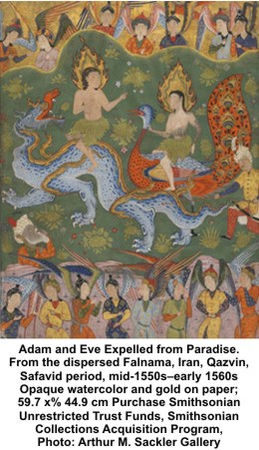“Falnama: The Book of Omens” @ the Arthur M. Sackler Gallery
The Angel of Death Descends on Shaddad ibn Ad From the dispersed Falnama Iran, Qazvin, Safavid period, mid-1550-early1560s. Opqaque watercolor and gold on paper; 59.3 x 44.8 cm. Purchase -Smithsonian Unrestricted Trust Funds, Smithsonian Collections. Acquisition Program, and Dr. Arthur M. Sackler. Photo Arthur M. Sackler Gallery
WASHINGTON, DC. - A group of unusual, illustrated manuscripts called the Falnama that were once used by sultans, shahs and commoners to explore the unknown will be on view Oct. 24 through Jan. 24, 2010, at the Smithsonian’s Arthur M. Sackler Gallery. “Falnama: The Book of Omens” is the first exhibition ever to be devoted to these rare works, which were created in 16th- and 17th-century Iran and Turkey. The Sackler Gallery will be the sole venue for this international exhibition featuring works of art from public and private collections. The works on view come from the Topkapı Palace Library in Istanbul, the Metropolitan Museum of Art in New York, the Chester Beatty Library in Dublin, the Louvre Museum in Paris and the Freer Gallery of Art. The exhibition will include more than 20 of the 29 folios of the so-called dispersed Falnama, created during the reign of the Safavid ruler Shah Tahmasb (reigned 1524-76), as well as never-before-seen folios from Ahmed I’s copy and a third unpublished volume.
Arresting images, supersaturated color and dazzling detail confronted seekers of omens in these oversized books. Adam and Eve ride out of paradise on the backs of a spectacular, dragon-like serpent and an equally fanciful peacock while startled angels look on. On another page, the angel of death in the guise of a ferocious gray demon drops out of the sky to pounce on Shaddad ibn Ad, who, according to the Koran, transgressed by daring to recreate paradise on Earth. On yet another page, the most celebrated physician of antiquity, Hippocrates, looks calmly over his shoulder as he travels through deep azure skies on the back of a mythical bird.
“Falnama illustrations possess a theatricality that sets them apart from other contemporary works,” said Massumeh Farhad, chief curator and curator of Islamic art at the Freer and Sackler galleries and organizer of the exhibition.  While some versions of Falnama were popular in the streets and marketplaces of Isfahan, Iran, and Istanbul, Turkey, where fortunetellers improvised divinations for paying customers, four “monumental” volumes, notable for their scale, bold compositions and brilliant palette, were created for use in more affluent and courtly circles. Three of these volumes will be on display in the exhibition.
While some versions of Falnama were popular in the streets and marketplaces of Isfahan, Iran, and Istanbul, Turkey, where fortunetellers improvised divinations for paying customers, four “monumental” volumes, notable for their scale, bold compositions and brilliant palette, were created for use in more affluent and courtly circles. Three of these volumes will be on display in the exhibition.
The most widely published and now dispersed copy of the Falnama was created in the late 1550s to early 1560s at the court of Shah Tahmasb at a time when he had become increasingly preoccupied with his legacy and recounted his memoirs in seven vivid dreams. Another copy of the Falnama was compiled and illuminated by Kalender Pasha, a vizier at the court of Ahmed I (reigned 1603-17), the Ottoman sultan and patron of the celebrated “Blue” mosque.
To consult the wisdom of the Falnama, a seeker would first perform ritual ablutions and recite certain prayers before opening the manuscript randomly to an image and its accompanying text. Much like a talisman or a planetary configuration, the image was the key to unlocking the meaning of the omen. “They appeal to our common desire to know what the future holds and our need for guidance and protection in an uncertain world,” said Farhad.
The manuscripts contain a range of images, from planets and zodiac signs to the lives and deeds of Abrahmic and Islamic saints and prophets, and were meant to aid a seeker in the process of making difficult decisions—from embarking on a voyage to waging war against an enemy. When seen as a group, the images suggest a vibrant and shared religious culture, embracing universal moral and ethical values. Seekers were encouraged to emulate the ethical and moral behavior of the prophets and saints portrayed in the Falnama.
“People clearly enjoyed the more fanciful aspects of divination, but they also took seriously the precepts of religion and morality reinforced in these very powerful images and prognostications,” said Farhad.

/https%3A%2F%2Fprofilepics.canalblog.com%2Fprofilepics%2F1%2F0%2F100183.jpg)



/http%3A%2F%2Fstorage.canalblog.com%2F08%2F81%2F119589%2F64665930_p.jpg)
/http%3A%2F%2Fstorage.canalblog.com%2F61%2F98%2F577050%2F60590664_o.jpg)
/http%3A%2F%2Fstorage.canalblog.com%2F21%2F98%2F577050%2F59713345_o.jpg)
/http%3A%2F%2Fstorage.canalblog.com%2F87%2F02%2F119589%2F54657744_p.jpg)